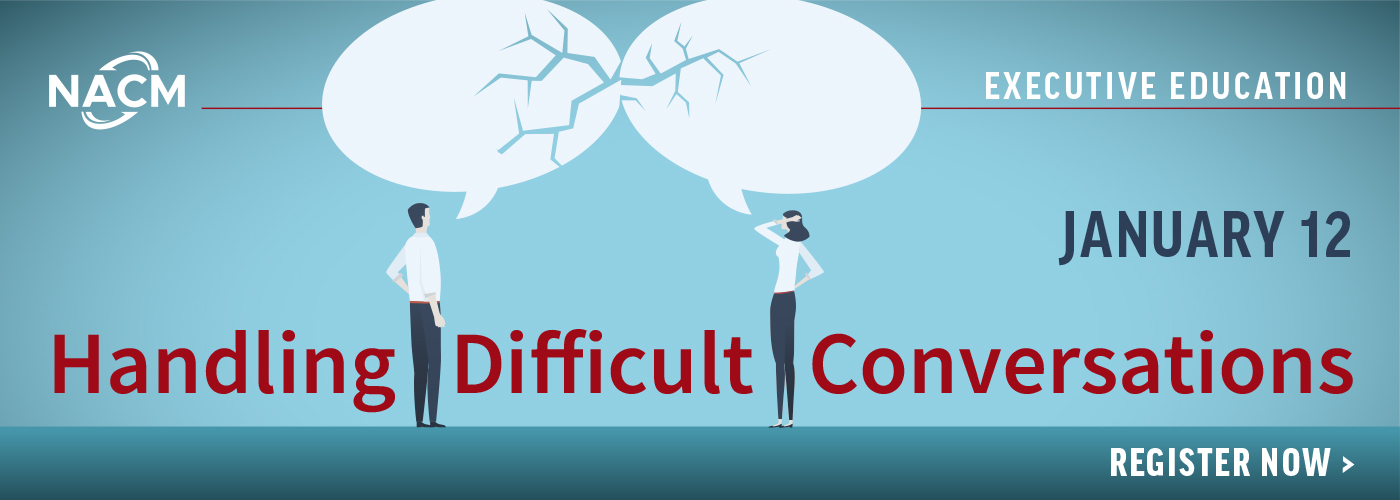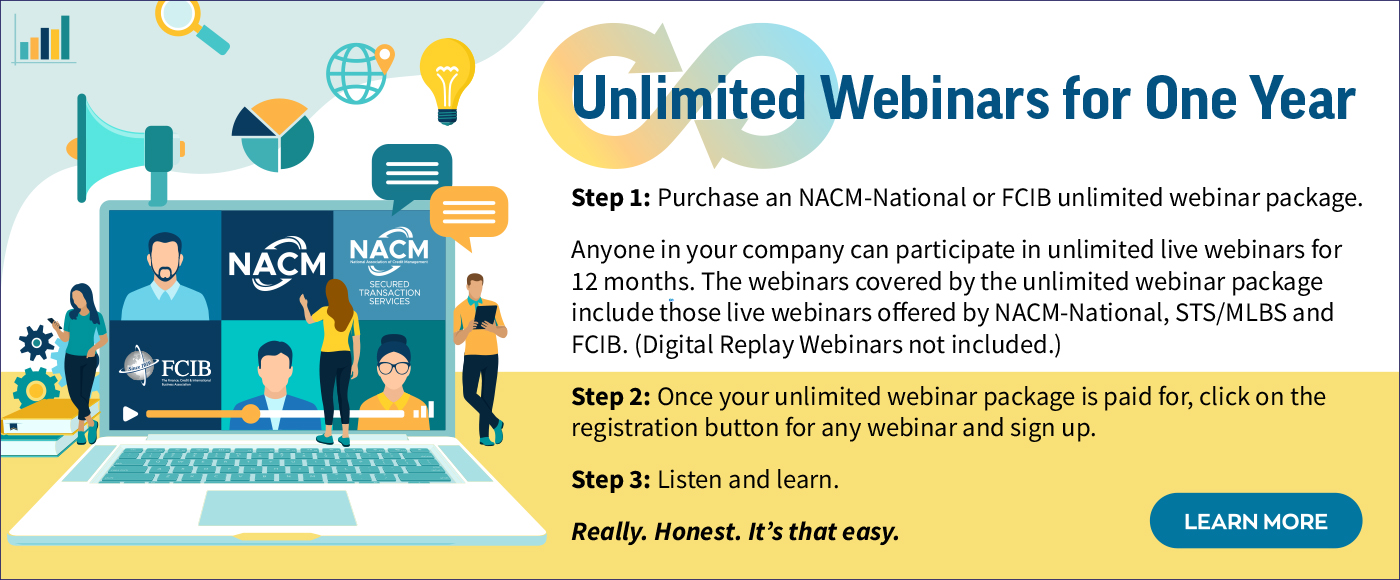eNews January 7
In the News
January 7, 2021
NACM’s December Credit Managers’ Index Remains Strong
—Michael Miller, NACM managing editor
NACM’s Credit Managers’ Index (CMI) held strong in December with a combined score of 57.8, down a tenth of a point from November and 0.6 points from the high in October. December’s score is more than three points higher than December 2019. “It now appears that the movement has slowed, and what we are seeing now could be considered normal or at least some version of normal,” said NACM Economist Chris Kuehl, Ph.D.
Sales drove the improvement in the favorable factors, jumping from 66.5 to 70.2 in December. New credit applications increased half a point to 64.4 as did amount of credit extended (64.8 to 65.3) in December. Dollar collections inched forward two-tenths of a point to 62.8 in the latest CMI. The combined four favorable factors index improved to 65.7 in December from 64.4 the previous month.
The combined six unfavorable factors index slipped one point in December to 52.5. Disputes was the only unfavorable factor to improve from 50.6 to 51.2, yet all six factors remained in expansion territory with scores above 50 for a second month in a row. Rejections of credit applications fell two-tenths of a point to 51.3 as did dollar amount of customer deductions from 51.7 to 51.5 in December. Accounts placed for collection dropped from 56.2 to 51.6, and dollar amount beyond terms slipped from 58.1 to 57. Filings for bankruptcies dipped a half point to 52.5. “Despite some weakening of the data in the unfavorable category all the readings are in expansion territory … The favorables are all at least in the 60s this month as well, and that points in a positive direction going into the first quarter.”
The manufacturing sector saw some leaps in the favorables. New credit applications increased from 62.4 to 70.2 in December, and dollar collections and amount of credit extended each jumped more than three points. Dollar collections came in at 65.9 compared to 62.3, while amount of credit extended was at 66.8 compared to 62.6. Sales went from 69.9 in November to 71.1 in December to round out the favorable index at 68.5 for the month, up from 64.3 in November. The unfavorable factors caused some trouble for credit professionals, with a huge drop in accounts placed for collection. The factor went from 63 in November to 51.4 in December. Rejections of credit applications declined to 51.3 from 52.5, and dollar amount beyond terms sank to 53.5 from 58.9. Disputes climbed out of contraction territory at 49.8 to land at 50.7 in December. Dollar amount of customer deductions slipped from 51 to 50.6 in December, and filings for bankruptcies dropped from 53.7 to 52.8. The overall manufacturing index declined two-tenths of a point in December to sit at 58.4.
The service sector remained relatively unchanged with an overall score of 57.1 compared to 57.2 in November. Sales increased from 63.1 to 69.3, but new credit applications, dollar collections and amount of credit extended fell. New credit applications declined from 65.4 to 58.7, and dollar collections dipped under 60 as well at 59.7 compared to 62.9 in November. Amount of credit extended fell to 63.9 after a showing of 67 in November. Four of the six unfavorables saw an improvement in December. Rejections of credit applications went from 50.4 to 51.2, while accounts placed for collection emerged from contraction territory at 51.8 compared to 49.4. Disputes improved slightly from 51.4 to 51.7, and dollar amount beyond terms shot up to 60.6 from 57.4. Dollar amount of customer deductions was unchanged at 52.4, but filings for bankruptcies declined two-tenths of a point to 52.2.
“The stability that has been noted over the last few months was shaken a little by the resumption of lockdowns, but thus far, this impact has not shaken the index off a course that puts it solidly in the expansion zone,” concluded Kuehl.
Fraud Tackles COVID-19 Vaccine Distribution
—Andrew Michaels, NACM editorial associate
It might be a new year, but there are some problems the business-to-business credit profession can’t leave behind. Fraud continues to breach professional and personal cybersecurity platforms across the U.S., most recently related to the COVID-19 vaccine distribution plan. The Financial Crimes Enforcement Network (FinCEN) issued an alert on Dec. 28 to financial institutions to be wary of potential “fraud, ransomware attacks, or similar types or criminal activity” involving the vaccine and/or its distribution.
In recent weeks, the U.S. Food and Drug Administration (FDA) approved the emergency use of two COVID-19 vaccines from Pfizer-BioNTech and Moderna, while three additional vaccines remain in clinical trials. Fraudsters have now taken that information to update and enhance their strategies by offering “the sale of unapproved and illegally marketed vaccines, the sale of counterfeit versions of approved vaccines, and illegal diversion of legitimate vaccines,” according to FinCEN.
“Already, fraudsters have offered, for a fee, to provide potential victims with the vaccine sooner than permitted under the applicable vaccine distribution plan,” the FinCEN statement reports. “In addition, cybercriminals, including ransomware operators, will continue to exploit the COVID-19 pandemic alongside legitimate efforts to develop, distribute, and administer vaccines.”
The bureau within the U.S. Department of Treasury also noted it is aware of ransomware targeted at vaccine research, vaccine delivery operations and supply chain manufacturers, and asks all cases of such activity to be reported through its Suspicious Activity Reports (SARs).
There are a variety of ways companies can protect themselves and prevent fraud and other financial crimes, which Andrew Davies, vice president of global market strategy for the Financial Crime Risk Management business at Fiserv, said have morphed and proliferated at an unprecedented rate since the onset of the pandemic. As early as April 2020, the Federal Trade Commission saw reported fraud attacks quadruple, later reporting in September 2020 that more than 200,000 Americans lost $145 million related to COVID-19.
“An effective fraud prevention program starts with the tone from the top of the company,” Davies said. “It is in everyone’s interest to protect the company from fraud, and security is a differentiator. This tone from the top can be effectively manifested in a fraud program that contains three dimensions: education, processes and technology.”
All associates must be educated on internal and external fraud, he said, as well as receive frequent updates on emerging scams and new types of fraud. For example, synthetic identify fraud is the fastest growing financial crime in the U.S., according to the FBI. Businesses should make sure employees are able to identify potential synthetic identities.
Davies said in order to protect company assets, processes must also be defined, implementing checks and balances to ensure the company is protected. Fraud attacks are frequently conducted by sophisticated organized crime groups who are experts in undermining technology and manipulating individuals.
“The final dimension companies must consider is technology, which includes monitoring software and the data driving the software. The U.S. has more information today than ever before and companies can utilize the inherent value in the data to protect themselves from fraud attacks and other nefarious activities like denial-of-service attacks,” Davies said. “Focusing on the combination of education (including educating customers), processes and technology, will help prevent fraud attacks and fraud losses.”
For more information about Fiserv, please contact This email address is being protected from spambots. You need JavaScript enabled to view it.. Additional information on FinCEN’s Suspicious Activity Reports is available in their Dec. 28 notice.
Wash Your Hands, Wear a Mask and Read Your Contract
—J. Michael “Mike” Schiff, Esq.
In the midst of this pandemic, not to mention social upheaval, political chaos, and events of historic ramifications, everyone in the world right now is dealing with risk and uncertainty. Personal, family, professional, public, private, cultural, economic, it seems that if it is a noun, it is uncertain. We are coping, mitigating, avoiding, researching, practicing, worrying, preventing, ignoring, obsessing, arguing, placating, working… you can insert your verb here. Everything is at once stagnant and in flux. In this environment, it can be tempting to take work under any terms whatsoever, let alone unfavorable ones. But it is in an uncertain climate that the terms of the work have never been more important. While it may be anecdotal, I personally have seen an increase in the disputes arising out of back of the napkin agreements or purchase orders in lieu of contracts, or sometimes even with no written terms at all.
So, here is my Public Service Announcement (PSA): It may be one that’s fallen by the wayside in the face of more daunting and justifiably immediate concerns. Contractors, if you are fortunate enough to have work and the ability to perform it, you still need to read and negotiate your contracts, upstream and down. Deciding ahead of time exactly what will happen when things go sideways has never been more important.
This practice starts with understanding what is and is not in your contract, both before and after finalization. The attractiveness of locking down work in an uncertain environment seems to have made the usual list of bad habits more frequent and extreme. These are the mistakes we at the firm routinely counsel against:
- Relying on the bid as a contract document when it explicitly is not;
- Failing to review contract exhibits;
- Failing to identify and propose the exhibits that you want included;
- Failing to receive an actual signed copy of the contract (assuming you have not failed to obtain a written contract in the first place);
- Beginning work without a signed contract, or without having read what’s in it;
- When applicable, failing to get a copy of the payment bond, or confirming that there is one;
- Signing a contract that makes false statements;
- Failing to observe and record notice provisions (How, to whom, when, and under what circumstances is written notice required to avoid waiving certain rights and privileges?);
- Failing to understand where you fit into the chain of contracts, i.e., what tier are you?
- Failing to have your insurance broker review the requirements to verify you actually have them (as opposed to breaching the agreement before you even start the work);
- Failing to document the status of your work daily;
- Failing to respond to formal written notice.
While nothing in this list is as interesting or gratifying as doing the work and getting paid, finding yourself at the wrong end of a dispute and paying an attorney to tell you what you should have done is even less so, I can assure you.
Beyond making an effort to avoid common pitfalls, every contractor should also expect to encounter and evaluate routine provisions that answer important questions. The goal here does not always need to be to “win the contract”; that would violate the Golden Rule of Contracting (“Whoever has the gold make the rules”). It is still important to identify the following provisions if only to know what they say and how they work on your particular job. How else can you understand, and more importantly, put a price on your level of risk?
- Flow Down / Flow Through: Do any or all of the upstream contract terms flow through to yours? If so, what rights and remedies are incorporated by reference?
- Unforeseen Conditions: What happens if unforeseen difficulties are encountered? Did you agree to do a site inspection and assume the risk of unforeseen conditions thereafter?
- Scope of Work: It should go without saying that the contract needs to define the scope of the work to be completed. This isn’t just necessary to define your responsibility, but also to define what is not your responsibility.
- Indemnity: An indemnity is any agreement where one party assumes the liability of another, and there are strict and fairly recent rules regarding what an indemnity agreement in a construction contract may do, and what it may not. You should know every part of the contract where you might agree to take on the liability of another, and under what circumstances.
- Changes / Claims: Always read and understand your change provision, and be aware of what notice might be required, as well as what supporting documentation. Usually, failure to adhere to these basic principles waives any claim for a change before even getting to its merits. And of course, do not do additional work without either receiving a written change order, or having preserved your right to make a claim for a denied change order.
- Delay: What does the contract say about a schedule, and liability for failure to meet that schedule? Often, contracts will contain a “no-damages-for-delay” clause, which is exactly what it sounds like. They may provide that a time extension is the sole remedy for a non-contractor caused delay.
- Consequential Damages: If the agreement waives “consequential damages,” you likely cannot make any recovery for lost profit, overhead, or lost opportunities as part of a claim, should one arise.
- Force Majeure: This provision defines an agreement by the parties as to what might be an excused interruption in work due to factors beyond anyone’s control, such as, oh I don’t know… maybe a global pandemic? Conversely, a Force Majeure provision may not provide the protection you’d think, and there might be other provisions that do a better job of addressing your circumstances.
- Lien Waivers: What does the contract say about mechanics and materialman’s liens? Many might try to prohibit your ability to lien your work, altogether. Be aware that in Texas, such a provision is simply void and unenforceable. However, it would be a mistake not to strike any form of atypical lien waiver from an agreement, regardless. You likely will be required to provide a partial release of lien in exchange for progress payments, and one upon final payment, which is typical.
- Backcharges / Offsets: Look for provisions that define when the upstream party can withhold payment or even require you to pay them.
- Termination: How does the agreement define termination and/or default, and what are the rights of the parties in that event? Is there an opportunity to cure an event of default? Does the agreement differentiate between a termination for convenience and one for cause?
- Payment: When and how often are you to be paid? What do you have to show in order to receive payment? Is there a contingent pay (often called “pay-when-paid” or “pay-if-paid” clause)? These require an upstream party to receive payment for your work before they have any obligation to pay you, but each clause functions differently depending on its own verbiage.
- Warranty: What kind of warranties are you providing, and what types of warranties might be excluded? Just as importantly, what is being warranted to you?
- Dispute Resolution: Have you waived a right to a jury trial, or made an agreement to arbitrate any disputes? Is there project engineer that plays a role in resolving disputes? Are you required to mediate your dispute before filing a lawsuit? Where must you litigate any claims? All important questions, regardless of the answer.
There are likely to be any number of additional provisions that vary in size, complexity, and amount depending on the nature of the project. Knowing what’s in your agreement can help you determine how to negotiate, your means and methods for performance, and how to resolve any disputes.
Contractors stand by their word and their work. Honesty and integrity tend to be a construction lawyer’s most favorite things about their clients, and the main reason why we do what we do. But a handshake deal has never been a good idea. Now that nobody can shake hands and we’re all under some form of quarantine, there’s never been a better time to insist on a written contract, and to read the whole thing.
J. Michael “Mike” Schiff is senior counsel at Andrews Myers law firm. His practice focuses on both construction litigation and alternative dispute resolution, in which he represents general contractors, subcontractors, suppliers and owners in a variety of construction related disputes.

|
Difficult conversations in the workplace are inevitable. These types of conversations can create stress and destroy business relationships. How do tell someone you don’t appreciate a joke or the way that they tease you? It often comes down to being able to hold a difficult conversation with the person involved. Join communications guru, Kristin Scroggin, as she discusses how to approach those situations and more. This webinar will help you:
|
Demonstrations in Washington, D.C., escalated Wednesday, interrupting the process of certifying the Presidential election Electoral College votes. Thousands had gathered at the National Mall for a campaign-style rally about an hour before the MAGA supporters overran the Capitol for the first time since 1814. Some broke into offices while others stormed onto the House and Senate floors, where elected officials had gathered to conduct their constitutional duty to count electoral votes and confirm the election of Joseph R. Biden as President.
On what now can only be characterized as one of the darkest days in American political history, the chaotic day included four citizen fatalities and in excess of 52 arrests, according to Washington D.C.’s Chief of Police. After order was restored and late into the night, members of congress, who had been assailed in their workplace, reconvened to carry out their constitutional duty to formalize voters’ choice for the next president. Vice President Pence said, “To those who wreaked havoc in our Capitol today, you did not win.” “Violence never wins. Freedom wins. And this is still the people’s house.”
Meanwhile, the runoff results from Georgia's two Senate races project that Democrats will pick up both seats in a significant upset. This gives the Democrats control of the Senate with 50 seats and Vice President-elect Harris breaking ties. This is a significant shift that opens up the possibility for Democrats to pass legislation through the Senate's “reconciliation” process with a simple majority, and this also gives Democrats control over the Senate agenda and Committee activity for the first time in six years. Lastly, this will allow President-elect Biden to nominate and have confirmed senior members of his administration, resolving a concern that federal agencies would be forced to operate without leadership for several months or even years of his presidency.
The shift in power in the Senate presents some potential risks to collections activities, as Democrats have made efforts to put a moratorium on collections activities during the COVID-19 pandemic. That said, it also presents an opportunity to emphasize the differences between NACM members and the kinds of creditors that Democrats typically target, such as payday lenders. President-elect Biden has a history of supporting creditors during the bankruptcy process, and was a key vote in passing the Bankruptcy Abuse Prevention and Consumer Protection Act, the major Republican bankruptcy reform bill in 2005. His position has shifted slightly since then, as he has come out in favor of forgiveness for student loans and a Sen. Warren plan that makes it less expensive for individuals to file bankruptcy.
Despite this shift, his history on this issue demonstrates an understanding of the importance of the bankruptcy process and protecting creditors. Furthermore, we do not anticipate that corporate bankruptcies will be the focus of the democratic agenda, minimizing potential negative impacts on NACM members. We will closely follow these efforts over the next two years, especially as businesses start to file bankruptcy in response to COVID-19 business changes, which has the potential to launch a new wave of calls to reform the bankruptcy process.
PACE LLP is NACM’s Washington, D.C., lobbyist on federal issues that impact the business credit community.
|
Upcoming Webinars |
|
Jan 12 |
Handling Difficult Conversations
Speaker: Kristin Scroggin, genWHY Communications, Huntsville, AL |
| Customer Onboarding in the Digital Age
Speaker: Thomas Maletz, BSF Finance GmbH, North Rhine-Westphalia, Germany |
Jan 14 |
|
Jan 19 |
Forfaiting: Increase Your Competitiveness & Improve Cash Flow
Speaker: Greg Bernardi, London Forfaiting Americas Inc., New York, NY |
| Not so Peachy in Georgia: Mismanaging the Lien & Bond Process Speaker: Chris Ring, NACM’s Secured Transaction Services |
Jan 20 |
|
Jan 21 |
Metrics: Managing & Monitoring AR Health
Speaker: John Salek, Revenue Management Associates, LLC, Fairfield, CT |
| Author Chat Leadership Simple: Leading People to Lead Themselves Authors Steve Morris & Jill Morris |
Jan 21 |
|
Jan 26 |
Key Performance Indicators (KPIs) and Metrics for Your Financial Close Speaker: Chris Doxey, CAPP, CCSA, CICA, CPC, Doxey Inc., Paeonian Springs, VA |
| Risk Mitigation in Mexico in a Nutshell: Due Diligence & Secured Transactions Speaker: Romelio Hernandez, HMH Legal S.C., Tijuana-Baja California, Mexico |
Jan 28 |






